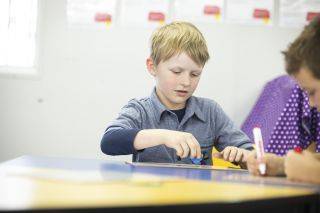
For student year
Helps students to
- regulate their feelings
- regulate their behaviour
Helps teachers to
- focus on teaching
- support student learning
Summary
Emotional and behavioural self-regulation is the ability to control or manage one’s feelings and behaviours. Self-regulation is a key part of the early years of schooling, and it increases as students understand the need to follow rules and develop their own internal value system. Self-regulation is influenced by:
- gender
- temperament
- cultural factors
- parenting styles
- life experiences.
Students take time to learn which behaviours are acceptable in which situations at home, school and in the community. Students take time to learn how to regulate feelings and behaviours by observing how people around them do this. You can assist students’ development by modelling appropriate self-regulation strategies and behaviours in the classroom.
However, some students may benefit from systematic instruction in the use of these strategies.
How the practice works
Watch this video to learn more about this practice.
Duration: 3:23
Preparing to teach
Seek support from:
- experienced teachers
- external support professionals e.g., school psychologists and guidance officers.
Take note of known stressors and minimise these.
Set the scene by identifying strategies, including environmental modifications, to support demands across:
- learning
- social
- sensorimotor.
The aim of these strategies is to:
- reduce the likelihood of students becoming overwhelmed and overstimulated
- increase on-task engagement and learning behaviours.
Plan to observe when your students:
- can self-regulate
- cannot self-regulate.
Become aware of activities when the student finds it difficult to self-regulate and identify a range of possible behaviours that could assist the student to self-regulate. For example:
- take deep breaths (it can help to have students exhale onto their hand; a long exhalation helps students to breathe in deeply and avoid rapid, shallow intake of breath)
- take a break from the activity.
Ask your colleagues for further suggestions (especially if they have worked with your students previously).
Plan explicit teaching of strategies and, when appropriate, for which particular situations.
Plan to teach these strategies when students are calm.
Plan and develop resources needed such as visual cue cards and social stories and ensure these resources are in place.
Identify and plan ahead of time, multiple opportunities for students to practise the behaviour/s including:
- role-play
- rehearsal scenarios.
These opportunities should:
- be referred to within the visual schedule
- have explicit and reasonable time-limits
- be supported by relevant visual classroom rule/s
- include acknowledgement of student attempts
- be followed by reward time.
It works better if:
- behaviour/s taught has been selected for instruction because it meets student need
- students’ emotions vocabulary is concurrently developed (see inclusionED practice Model Emotional Literacy).
It doesn’t work if:
- students are taught expected behaviour/s that are too hard for them to use even with scaffolding and support (i.e., sit outside of the zone of proximal development)
- teacher response to unregulated behaviour is punitive rather than instructional.
In the classroom
Step 1. Manage the environment
Modify and manage the environment as much as possible.
Step 2. Observe behaviours
Observe when students can and cannot self-regulate their feelings and behaviour, and take note of potential stressors.
During these activities or when stressors are present, ensure the necessary proactive modifications are in place.
Step 3. Identify behaviours
Identify one or more behaviours (e.g., deep breaths, taking a break) which might enable students to regulate their feelings or behaviour.
Step 4. Explicit teaching
Explicitly teach students the acceptable behaviour/s for particular situations.
Step 5. Provide opportunities
Provide multiple opportunities for students to practise the behaviour/s.
Step 6. Model behaviours
Model using the identified behaviour/s to regulate your own behaviour.
Model behaviours e.g., ‘Three big breaths’ and have students practise too.
Acknowledge and positively reinforce student attempts.
Remember (Steps 4 – 6)
- Communicate explicitly, describing the desired behaviours.
- Communicate in a calm, predictable and positive way.
- In the event that the activity is too overwhelming for a student, be prepared to allow him/her to take a break.
- If the activity has to be abandoned, communicate anticipation of a positive future outcome e.g., "All right, next time we’ll give it another try."
- Acknowledge and positively reinforce all student attempts.
Record
Keep a record to help gauge effectiveness of all strategies in supporting student progress.
Practice toolkit
Practice implementation planner template
We know it's not always easy to keep track of what's working and what isn't. So, we've created this template for you to record and reflect on what you're doing to create more inclusive classrooms. The implementation planner contains:
- guidance around goal setting
- a reflection section (what worked, didn’t work, what to change, and next steps)
- prompting questions.
Implementation planner with examples
Set your professional learning goal for:
Teach self-regulation
Benefits of goal setting
Setting, working towards, and reflecting on goals helps you grow professionally and improve your practice. You can access AITSL learning resources for teachers to learn more about:How to set goals
The Australian Institute for Teaching and School Leadership recommends using the SMART matrix to frame your goal setting.SMART goals refers to goals that are:
- Specific
- Measurable
- Achievable
- Relevant
- Time-phased
Resources
Teach self-regulation - Practice brief
Example visual support: Zones of regulation
Related Practices

Conduct an ABC analysis
TEACHING PRACTICE
For student years
Helps students to
- be accepted by their peers
- feel supported

Model emotional literacy
TEACHING PRACTICE
For student years
Helps students to
- identify and respond to emotions
- regulate emotions

Model positive interactions
TEACHING PRACTICE
For student years
Helps students to
- build social-awareness
- interact with others

Teach social problem solving
TEACHING PRACTICE
For student years
Helps students to
- solve social problems
- become independent
This practice is from the core research project
Learning Cycle

